英语四六级口语考试
- 格式:doc
- 大小:25.00 KB
- 文档页数:6
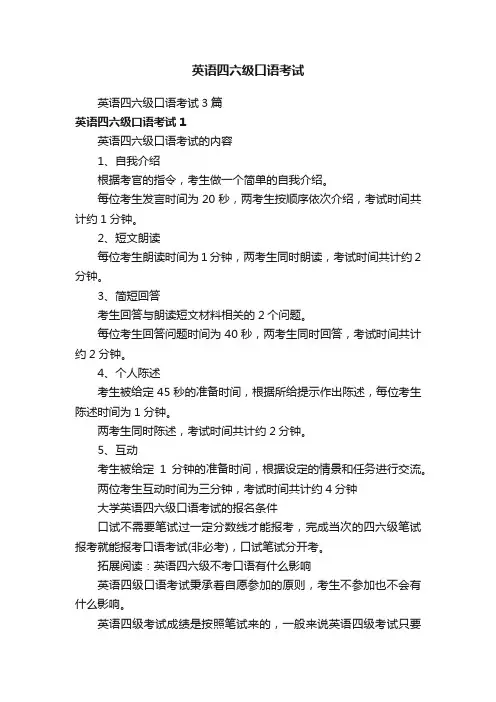
英语四六级口语考试英语四六级口语考试3篇英语四六级口语考试1英语四六级口语考试的内容1、自我介绍根据考官的指令,考生做一个简单的自我介绍。
每位考生发言时间为20秒,两考生按顺序依次介绍,考试时间共计约1分钟。
2、短文朗读每位考生朗读时间为1分钟,两考生同时朗读,考试时间共计约2分钟。
3、简短回答考生回答与朗读短文材料相关的2个问题。
每位考生回答问题时间为40秒,两考生同时回答,考试时间共计约2分钟。
4、个人陈述考生被给定45秒的准备时间,根据所给提示作出陈述,每位考生陈述时间为1分钟。
两考生同时陈述,考试时间共计约2分钟。
5、互动考生被给定1分钟的准备时间,根据设定的情景和任务进行交流。
两位考生互动时间为三分钟,考试时间共计约4分钟大学英语四六级口语考试的报名条件口试不需要笔试过一定分数线才能报考,完成当次的四六级笔试报考就能报考口语考试(非必考),口试笔试分开考。
拓展阅读:英语四六级不考口语有什么影响英语四级口语考试秉承着自愿参加的原则,考生不参加也不会有什么影响。
英语四级考试成绩是按照笔试来的,一般来说英语四级考试只要是达到220分以上就可以颁发成绩单,一般来说不设及格标准,但是一般来说把425分做为英语四级考试的及格标准,因为只有达到425以上才能考英语六级考试。
口语考试对总体成绩是没有影响的,不是要求必须考取的项目,考下英语四级口语,也不单独发成绩单,在笔试成绩单上统一体现成绩。
英语四六级口语考试2考试介绍1、考试对象:大学英语四、六级考试口语考试(CET Spoken English Test ,简称CET-SET)用于考察大学生运用英语进行口头交际的能力。
CET-SET 报考对象为获得全国大学英语四、六级证书且成绩达到一定分数线的在校大学生。
教育部规定,四级笔试550分、六级520分以上的考生可以报名参加口试。
2、考试时间及地点:四、六级口语考试为一年两次,分别在5月和11月。
考试地点在考生报名的考点,具体考场在考生报名后随机编组确定。
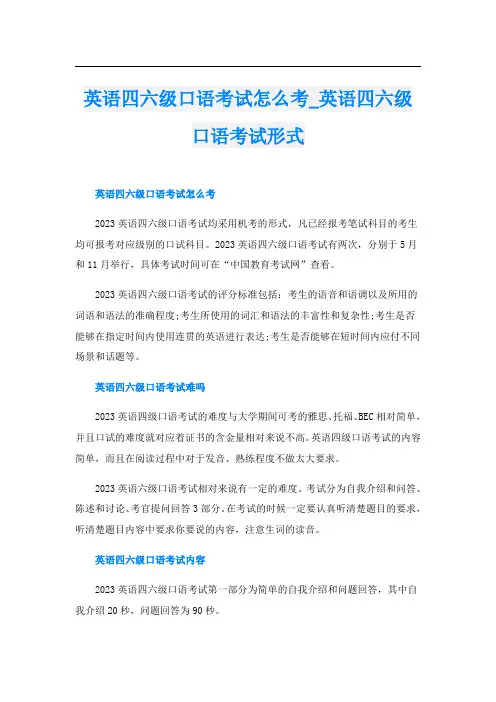
英语四六级口语考试怎么考_英语四六级口语考试形式英语四六级口语考试怎么考2023英语四六级口语考试均采用机考的形式,凡已经报考笔试科目的考生均可报考对应级别的口试科目。
2023英语四六级口语考试有两次,分别于5月和11月举行,具体考试时间可在“中国教育考试网”查看。
2023英语四六级口语考试的评分标准包括:考生的语音和语调以及所用的词语和语法的准确程度;考生所使用的词汇和语法的丰富性和复杂性;考生是否能够在指定时间内使用连贯的英语进行表达;考生是否能够在短时间内应付不同场景和话题等。
英语四六级口语考试难吗2023英语四级口语考试的难度与大学期间可考的雅思、托福、BEC相对简单,并且口试的难度就对应着证书的含金量相对来说不高。
英语四级口语考试的内容简单,而且在阅读过程中对于发音、熟练程度不做太大要求。
2023英语六级口语考试相对来说有一定的难度。
考试分为自我介绍和问答、陈述和讨论、考官提问回答3部分。
在考试的时候一定要认真听清楚题目的要求,听清楚题目内容中要求你要说的内容,注意生词的读音。
英语四六级口语考试内容2023英语四六级口语考试第一部分为简单的自我介绍和问题回答,其中自我介绍20秒,问题回答为90秒。
2023英语四六级口语考试第二部分为topic,及与你的partner进行有关此给出话题的讨论,时间为4分30秒。
2023英语四六级口语考试第三部分为总结式回答,包括两个问题,其中一个与你的partner相同,另一个不同。
时间均为90秒。
英语六级口语可以不考吗英语六级口语考试不是强制考的,就像很多人问有没有必要考四六级一样,要不要考口语,首先跟你的专业密切相关。
看专业、就业需要。
如果以后你所学专业就业需要体现口语能力,比如你是语言相关专业、涉外专业(包括但不限于国际贸易、旅游管理等),以后从事外事接待、解说等专业,财经类院校等,对口语有一定要求(而又没有达到非常专业的要求),请报名参加四六级口试英语六级口语考试难度英语六级考试难吗?确实有难度,很多裸考过四级的同学六级是裸不过去的,成绩在大多都在300分左右。
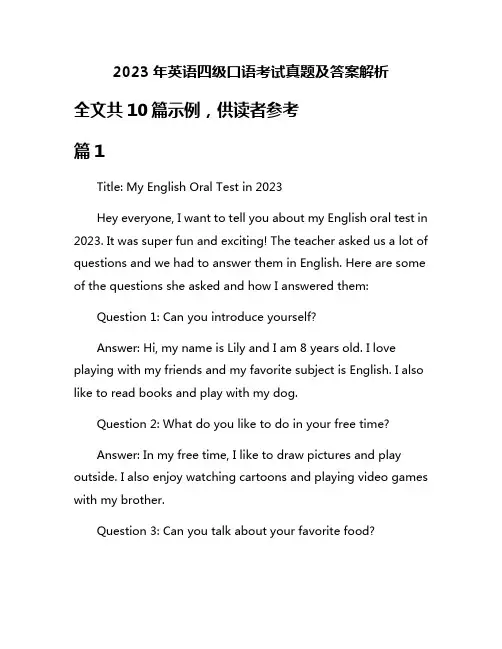
2023年英语四级口语考试真题及答案解析全文共10篇示例,供读者参考篇1Title: My English Oral Test in 2023Hey everyone, I want to tell you about my English oral test in 2023. It was super fun and exciting! The teacher asked us a lot of questions and we had to answer them in English. Here are some of the questions she asked and how I answered them:Question 1: Can you introduce yourself?Answer: Hi, my name is Lily and I am 8 years old. I love playing with my friends and my favorite subject is English. I also like to read books and play with my dog.Question 2: What do you like to do in your free time?Answer: In my free time, I like to draw pictures and play outside. I also enjoy watching cartoons and playing video games with my brother.Question 3: Can you talk about your favorite food?Answer: My favorite food is pizza! I love how cheesy and delicious it is. I also like ice cream and chocolate cake.Question 4: Do you have any pets?Answer: Yes, I have a pet dog named Max. He is very fluffy and playful. I love taking him for walks and cuddling with him.Question 5: What is your dream job?Answer: When I grow up, I want to be a teacher. I love helping others learn new things and I think it would be a fun job.Overall, the oral test was a great experience and I had so much fun answering all the questions in English. I can't wait for the next test!篇2Title: My Experience of the 2023 English Proficiency Speaking TestHey guys, today I'm gonna share with you my experience of the 2023 English proficiency speaking test. It was supernerve-wracking but also kinda fun, so let me tell you all about it!So, the test started with the examiner asking me some questions about myself, like where I'm from and what I like to doin my free time. I was a bit nervous at first, but I tried to stay calm and answer the questions as best as I could.Then, we moved on to the second part of the test, which was a discussion about a random topic. The examiner asked me what I thought about robots taking over our jobs in the future. I was like, "Whoa, that's a tough question!" But I tried my best to give my opinion and support it with some reasons.After that, we had a role-play where I had to pretend to be a customer at a restaurant and ask for recommendations from the waiter. It was kinda funny pretending to be someone else, but I enjoyed it and tried to be as natural as possible.The last part of the test was a short presentation about a famous person in history. I chose to talk about Martin Luther King Jr. and his fight for civil rights. I was really passionate about this topic, so I felt confident and spoke from the heart.Overall, the test was challenging but also a great learning experience. I learned to speak confidently and express my thoughts clearly in English. It was definitely a test to remember!So, if you're gonna take the English speaking test soon, don't worry too much. Just be yourself, stay calm, and most importantly, have fun with it! Good luck, guys!篇3Title: 2023 English Proficiency Test for Primary School Students: Questions and AnswersQuestion 1: Can you introduce yourself?Answer: Hi! My name is Lily. I am 10 years old. I live in a small town with my parents and my little brother. I love to play soccer and draw pictures in my free time.Question 2: What is your favorite subject in school and why?Answer: My favorite subject in school is English because I like to learn new words and read interesting stories. I also enjoy writing in English because I can express my thoughts and ideas.Question 3: Do you prefer studying alone or in a group? Why?Answer: I prefer studying in a group because I can ask my friends for help when I don't understand something. It's also more fun to study together and share ideas with each other.Question 4: What do you do to improve your English skills outside of school?Answer: I like to watch English cartoons and listen to English songs. I also practice speaking English with my friends when we play games together. It helps me to become more confident in speaking English.Question 5: How do you think English will be important for your future?Answer: I think English is important for my future because it is a global language. It will help me to communicate with people from different countries and cultures. It will also open up more opportunities for me in the future.Overall, the 2023 English Proficiency Test for Primary School Students focuses on assessing students' English speaking skills and their ability to express themselves in English. It encourages students to practice English in their daily lives and emphasizes the importance of English for their future.篇4Hello everyone! Today I will tell you about the 2023 English Four Level Speaking Test. Let's get started!Part 1:Question 1: Can you introduce yourself?Answer: Hi, my name is Tommy. I am ten years old and I like playing soccer and reading books.Question 2: What do you like to do in your free time?Answer: In my free time, I like to play video games with my friends and go to the park to play soccer.Question 3: Do you have any hobbies?Answer: Yes, I love drawing and painting. I also enjoy singing and dancing.Part 2:Question 1: What is your favorite season and why?Answer: My favorite season is summer because I can go swimming and play outside with my friends.Question 2: How do you usually spend your weekends?Answer: On weekends, I like to visit my grandparents and play board games with them. Sometimes we go to the movies or have a picnic in the park.Question 3: What is your dream job?Answer: My dream job is to become a pilot. I want to travel around the world and see different countries.Part 3:Question 1: Do you think it's important to learn a second language? Why?Answer: Yes, I think it's important to learn a second language because it helps us communicate with people from different countries and understand different cultures.Question 2: What is your favorite subject in school and why?Answer: My favorite subject in school is math because I like solving problems and learning new things.Question 3: How do you think technology has changed our lives?Answer: Technology has made our lives easier and more convenient. We can communicate with people from all over the world and access information quickly.That's it for the 2023 English Four Level Speaking Test. I hope you find this helpful and good luck with your own test! Bye bye!篇5Hello everyone! Today I'm going to talk about the 2023 English CET-4 speaking test. It was super fun and exciting!First, let me tell you about the topic of the test. It was all about traveling. The examiner asked me questions like "Where would you like to travel to?" and "What kind of transportation do you prefer for traveling?" I talked about how I want to visit Australia and how I love traveling by airplane because it's so cool to fly high in the sky.Then, the examiner gave me a picture and asked me to describe it. It was a beautiful beach with clear blue water and white sand. I said that I would love to go there and swim in the ocean because it looks so peaceful and relaxing.After that, I had to talk about a famous person I admire. I chose Taylor Swift because she is a talented singer and songwriter. I talked about her music and how she inspires me to follow my dreams.Overall, the test was so much fun! I spoke confidently and fluently, and the examiner was really nice and encouraging. I can't wait to see my results and find out how well I did.I hope you all have a great time taking the English CET-4 speaking test too! Good luck!篇6Title: 2023 CET-4 Oral Exam Questions and Answers AnalysisHey guys, have you ever wondered what kind of questions are asked in the English CET-4 oral exam? Well, let me tell you all about it! In the 2023 CET-4 oral exam, there were three main questions that were asked, and I'll give you the answers and analysis for each one.Question 1: Talk about a memorable trip you have taken.Answer: I once went on a trip to the beach with my family. We stayed in a cozy beach house and spent our days swimming, building sandcastles, and collecting seashells. It was so much fun and I will never forget the beautiful sunsets we watched together.Analysis: This is a typical question in the oral exam that asks you to talk about a personal experience. It's important to include details and describe your feelings to make your answer more interesting.Question 2: Discuss the impact of technology on society.Answer: Technology has changed the way we live in so many ways. We can now communicate with people from all over theworld, access information instantly, and even work from home. However, it has also led to issues like cyberbullying and privacy concerns.Analysis: This question requires you to provide your opinion on a current issue. Make sure to give examples to support your arguments and consider both the positive and negative aspects of technology.Question 3: Describe a book or movie that has inspired you.Answer: The Harry Potter series by J.K. Rowling has inspired me in many ways. The story of a young boy discovering his magical powers and fighting against evil forces taught me valuable lessons about courage, friendship, and the power of love.Analysis: This question asks you to discuss a piece of literature or media that has had an impact on you. Be sure to explain why it was inspiring to you and how it has influenced your thoughts or actions.Overall, the key to doing well in the CET-4 oral exam is to practice speaking English regularly and be confident in expressing your ideas. Remember to speak clearly, use correctgrammar and vocabulary, and most importantly, have fun with it! Good luck in your exam, guys!篇7Hello everyone! Today, I'm going to share with you the questions and answers from the 2023 English-4 exam. Keep in mind that this is just for fun and practice, so don't stress out too much about it. Let's get started!Question 1: What is your favorite movie and why?Answer: My favorite movie is "Toy Story" because it's so cool to see toys coming to life and having adventures. The characters are funny and the story is really exciting. I love watching it again and again!Question 2: Do you prefer reading books or watching TV shows? Why?Answer: I prefer reading books because they let me use my imagination and picture the story in my mind. TV shows are fun too, but books make me feel more connected to the characters and the plot.Question 3: What do you like to do in your free time?Answer: In my free time, I like to play with my friends, draw pictures, and read books. I also enjoy going to the park and playing sports like soccer and basketball. It's important to have fun and relax after a busy day at school!Question 4: Describe your favorite vacation spot and why you love it.Answer: My favorite vacation spot is the beach because I love swimming in the ocean, building sandcastles, and collecting seashells. The sound of the waves and the feeling of the warm sun on my skin make me feel so happy and relaxed.Question 5: How do you think technology has changed the way we communicate with each other?Answer: Technology has made it easier to stay in touch with friends and family through text messages, video calls, and social media. However, it's also important to remember to talkface-to-face and spend quality time together without distractions from our devices.I hope you enjoyed these questions and answers from the 2023 English-4 exam! Remember to practice your English skills every day and have fun with the language. Good luck with your studies and keep up the great work!篇8Sure! Here is a playful and casual version of a 【2023】:Hey there, guys and girls! So today I wanna talk about the English CET-4 speaking exam in 2023. It's like, super important, you know? So let's dive into it!First off, the examiners might ask you to talk about your favorite movie or book. You gotta be ready to share some deets about it, like who the main characters are and why you like it so much. For example, you could talk about how Harry Potter is your fave book 'cause it's full of magic and adventure – cool, right?Next up, they might ask you to describe a place you wanna visit. Maybe you'll say you wanna go to Paris 'cause of the Eiffel Tower and yummy pastries. Just make sure to add some details to really paint a picture in their minds!Then, you might have to give your opinions on topics like technology or environmental issues. Remember to use some good vocab like "beneficial" or "harmful" to show you know your stuff. And don't forget to give reasons for your views!Finally, there's the part where you gotta talk with a partner about a given topic. Make sure to listen to what they say and respond with your own thoughts. It's all about working together and showing off your English skills!Overall, just be confident, speak clearly, and don't stress too much. The examiners just wanna see how well you can communicate in English. So give it your best shot and rock that CET-4 speaking exam!Good luck, everyone! You got this!篇9Oh my gosh! Guess what guys? I just took the English oral test for the 2023 English Proficiency Test! It was super fun and a little nerve-wracking, but I think I did pretty well. I'm gonna tell you all about it, so you can be ready when it's your turn!So, the first part of the test was all about introducing myself. The examiner asked me to talk about my hobbies, my favorite things, and where I come from. I told him all about how much I love playing soccer, reading books, and hanging out with my friends. I also said that I'm from a small town in China called Xi'an. The examiner was really nice and made me feel comfortable, so I was able to speak confidently.Next, we moved on to the second part of the test, which was all about describing a picture. They showed me a picture of a beautiful beach with palm trees and clear blue water. I had to talk about what I saw in the picture and how it made me feel. I said that the beach looked super relaxing and that I wished I could be there right now. I also mentioned how much I love going to the beach with my family in the summer.The third part of the test was a role play situation. The examiner pretended to be a lost tourist in my town, and I had to help him find his way to a famous landmark. I had to give him directions and answer his questions about the best places to visit.I told him about all the cool things to see and do in Xi'an, like the Terracotta Warriors and the Big Wild Goose Pagoda. The examiner seemed really impressed with my knowledge of the city.Finally, we finished the test with a discussion about a current issue. The examiner asked me to talk about the importance of learning a second language. I said that learning a second language can open up so many opportunities for us, like making new friends, getting better jobs, and experiencing different cultures. I also talked about how learning English has helped mecommunicate with people from all over the world and how much fun it is to speak in a different language.Overall, I think I did a great job on the English oral test! I spoke clearly, answered the questions confidently, and showed off my English skills. I hope this helps you guys prepare for your own test – just remember to be yourself, stay calm, and speak from the heart. Good luck!篇10Title: 2023 CET-4 Oral Test Questions and Answer AnalysisHey guys! Today I'm gonna share with you the questions and answers from the 2023 CET-4 Oral Test. Let's get started!Question 1: Introduce yourself.Answer: Hi! My name is Tim. I’m a student from Beijing. I love playing soccer and watching movies in my free time. Nice to meet you all!Question 2: What is your favorite hobby and why?Answer: My favorite hobby is playing video games. They are so fun and exciting! I can relax and have a good time after a long day of studying.Question 3: Describe your dream vacation.Answer: My dream vacation would be traveling to Japan. I want to visit Tokyo and see all the cool things like anime stores and beautiful temples. It would be so much fun!Question 4: Talk about a technology that has changed your life.Answer: The smartphone has changed my life a lot. I can easily communicate with my friends and family, listen to music, and even do my homework on it. It's like having a mini computer in my pocket!Question 5: How do you think technology will impact our future?Answer: I think technology will continue to change our lives in the future. We will have more advanced gadgets and tools that will make things easier for us. But we also need to be careful and use technology wisely.Overall, the CET-4 Oral Test questions were fun and interesting to answer. I hope my answers can help you prepare for your own test. Good luck to everyone taking the exam!。
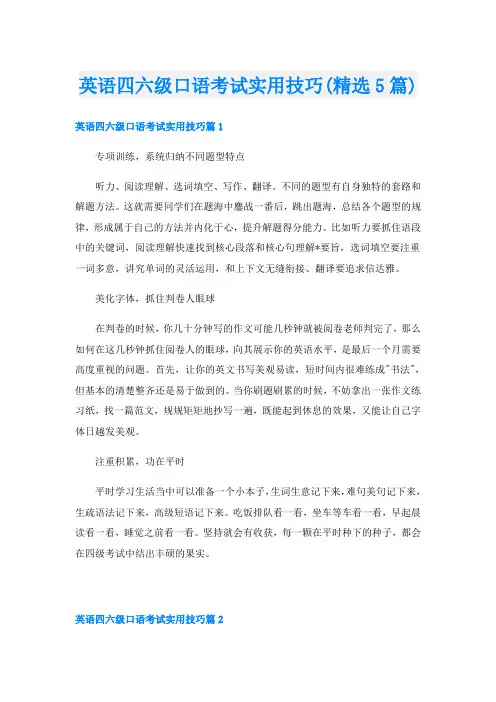
英语四六级口语考试实用技巧(精选5篇)英语四六级口语考试实用技巧篇1专项训练,系统归纳不同题型特点听力、阅读理解、选词填空、写作、翻译。
不同的题型有自身独特的套路和解题方法。
这就需要同学们在题海中鏖战一番后,跳出题海,总结各个题型的规律,形成属于自己的方法并内化于心,提升解题得分能力。
比如听力要抓住语段中的关键词,阅读理解快速找到核心段落和核心句理解*要旨,选词填空要注重一词多意,讲究单词的灵活运用,和上下文无缝衔接、翻译要追求信达雅。
美化字体,抓住判卷人眼球在判卷的时候,你几十分钟写的作文可能几秒钟就被阅卷老师判完了,那么如何在这几秒钟抓住阅卷人的眼球,向其展示你的英语水平,是最后一个月需要高度重视的问题。
首先,让你的英文书写美观易读,短时间内很难练成"书法",但基本的清楚整齐还是易于做到的。
当你刷题刷累的时候,不妨拿出一张作文练习纸,找一篇范文,规规矩矩地抄写一遍,既能起到休息的效果,又能让自己字体日越发美观。
注重积累,功在平时平时学习生活当中可以准备一个小本子,生词生意记下来,难句美句记下来,生疏语法记下来,高级短语记下来。
吃饭排队看一看,坐车等车看一看,早起晨读看一看,睡觉之前看一看。
坚持就会有收获,每一颗在平时种下的种子,都会在四级考试中结出丰硕的果实。
英语四六级口语考试实用技巧篇2在英语的学习过程中,大家一定要把效率放在第一位,要知道我们花费的每一分钟都应该有它的价值,所以,无论是背单词还是练习听力,都要认真、高效的完成。
学习英语要合理划分阶段,学习英语最不该犯的错误就是贪多求全,这是很多人在学习英语上的通病。
要提高英语学习效率,就必须要分清楚英语学习的每一个阶段应该学什么内容,将主要精力放在核心内容上,这样才能事半功倍。
模仿是学习英语的主要方法之一,所谓模仿是指语音语调都很接近被模仿者的语言,模仿练习时,需要克服害羞和自卑,要敢说,敢模仿。
很多人在学习英语的时候,往往是很不情愿的,所以,学习的积极性不是很高。

英语四六级口语有什么考试用处英语四六级口语考试用处1.国外交换生/出国留学英语是很多国家的官方语言,所以,掌握英语四六级口语,相当于拥有了在很多国家学习深造的机会。
不管是本科生,还是硕士生、博士生,一些学校每年都会有对外交流项目。
只要你满足一定条件,就可以申请。
2.四六级口语对考研是复试拉分项很多同学过了考研初试,但考研复试被刷,其中重要的原因就是四六级口语太差!口语能力考研复试必定考察的内容,包括英文的自我介绍和日常的提问交流,这个和四六级口语、雅思口语考试很像。
如果你的四六级口语能力很出众,必然会在竞争激烈的考研复试中脱颖而出!3.实习就业,升职加薪好帮手现在很多企业都和外企有合作,如果大家想在企业立足,在保证优异业绩的同时,掌握一口流利的英语四六级口语,能无障碍地与外企的同事、老板交流,才能受到企业的重视,更好的实现自己的价值。
英语四六级重要吗对于学生来说,参加四六级的考试具有重要的作用,通过四六级的考试,也有一定的影响。
现在许多公务员单位或者是国企私人企业,在招聘的时候,对人才都有在外语方面的要求,而四六级就是他们划分的一个维度。
不少的岗位在招聘时要求考生通过四级或者是六级,甚至在一些外企会有要求达到具体的分数。
所以对于现在的很多在校学生来说,通过四六级已经成为他们的一个目标了。
从社会层面来说,英语四六级考试的设置也推动了师生学习英语的积极性,大大提升了我国青年的英语水平,在一定程度在一定程度上,也为我国提升综合文化实力起到了一定的作用。
英语四六级在校生可以考几次英语四级可以考的次数为:只要是在校大学生,都是可以考的。
具体次数如下:1、本科生从大一开始考,可以考8次。
2、本科生从大二开始考,可以考6次。
3、专科生从大一开始考,可以考6次。
4、专科生从大二开始考,可以考4次。
5、如果是研究生的话,一年增加2次考英语四级的机会(不过一般研究生都是考英语六级,四级早通过了)。
四六级可以一起考吗四六级不可以一起考。
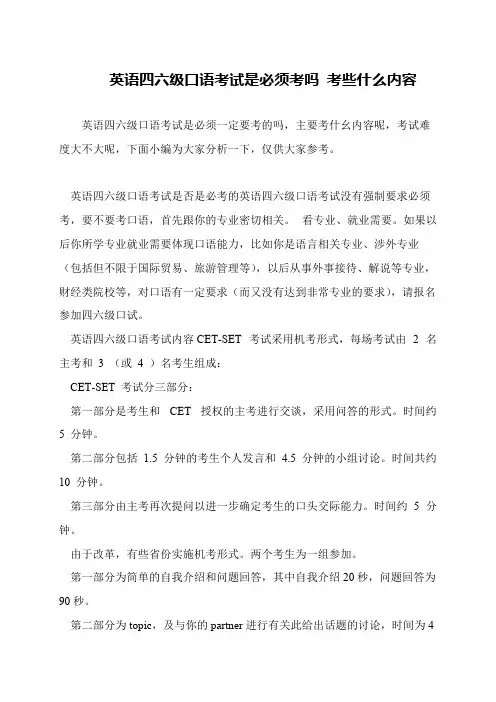
英语四六级口语考试是必须考吗考些什么内容
英语四六级口语考试是必须一定要考的吗,主要考什幺内容呢,考试难度大不大呢,下面小编为大家分析一下,仅供大家参考。
英语四六级口语考试是否是必考的英语四六级口语考试没有强制要求必须考,要不要考口语,首先跟你的专业密切相关。
看专业、就业需要。
如果以后你所学专业就业需要体现口语能力,比如你是语言相关专业、涉外专业(包括但不限于国际贸易、旅游管理等),以后从事外事接待、解说等专业,财经类院校等,对口语有一定要求(而又没有达到非常专业的要求),请报名参加四六级口试。
英语四六级口语考试内容CET-SET 考试采用机考形式,每场考试由 2 名主考和 3 (或 4 )名考生组成:
CET-SET 考试分三部分:
第一部分是考生和CET 授权的主考进行交谈,采用问答的形式。
时间约5 分钟。
第二部分包括1.5 分钟的考生个人发言和4.5 分钟的小组讨论。
时间共约10 分钟。
第三部分由主考再次提问以进一步确定考生的口头交际能力。
时间约5 分钟。
由于改革,有些省份实施机考形式。
两个考生为一组参加。
第一部分为简单的自我介绍和问题回答,其中自我介绍20秒,问题回答为90秒。
第二部分为topic,及与你的partner进行有关此给出话题的讨论,时间为4。
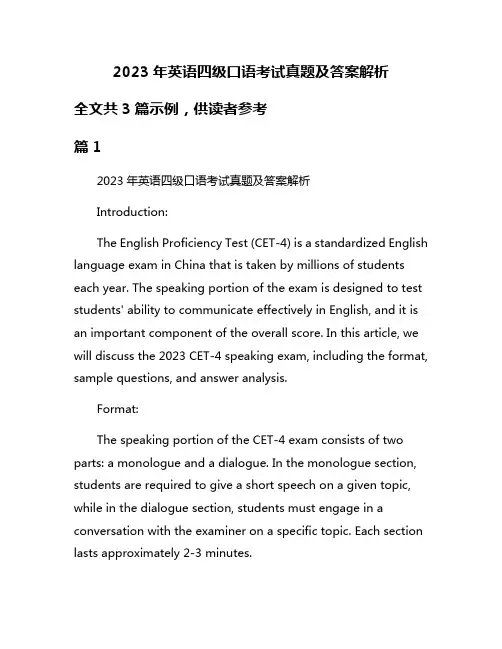
2023年英语四级口语考试真题及答案解析全文共3篇示例,供读者参考篇12023年英语四级口语考试真题及答案解析Introduction:The English Proficiency Test (CET-4) is a standardized English language exam in China that is taken by millions of students each year. The speaking portion of the exam is designed to test students' ability to communicate effectively in English, and it is an important component of the overall score. In this article, we will discuss the 2023 CET-4 speaking exam, including the format, sample questions, and answer analysis.Format:The speaking portion of the CET-4 exam consists of two parts: a monologue and a dialogue. In the monologue section, students are required to give a short speech on a given topic, while in the dialogue section, students must engage in a conversation with the examiner on a specific topic. Each section lasts approximately 2-3 minutes.Sample Questions:Monologue:1. Describe your favorite holiday destination and explain why you enjoy it.2. Discuss the importance of teamwork in achieving goals.3. Talk about a memorable experience you had while studying abroad.Dialogue:1. Discuss the pros and cons of social media.2. Describe a book or movie that has had a significant impact on you.3. Talk about a recent environmental issue that you feel strongly about.Answer Analysis:In the monologue section, it is important for students to clearly articulate their ideas and provide specific examples to support their points. It is also crucial to maintain a good pace and use appropriate vocabulary and grammar. For example, when discussing a memorable experience studying abroad, astudent could talk about the challenges they faced, the friends they made, and the cultural differences they encountered.In the dialogue section, students should actively engage with the examiner and express their opinions clearly. It is important to listen carefully to the examiner's questions and provide relevant responses. For example, when discussing the pros and cons of social media, a student could talk about the benefits of staying connected with friends and family, as well as the negative effects of cyberbullying and addiction.Overall, the key to success in the CET-4 speaking exam is to practice regularly, expand vocabulary, and improve fluency. By following these tips and strategies, students can enhance their speaking skills and achieve a higher score on the exam.Conclusion:In conclusion, the 2023 CET-4 speaking exam is an important test of students' English proficiency and communication skills. By understanding the format, practicing sample questions, and analyzing answers, students can prepare effectively for the exam and improve their chances of success. With dedication and hard work, students can achieve their goals and demonstrate their English language abilities.篇22023年英语四级口语考试真题及答案解析Part 1: IntroductionIn the 2023 English Proficiency Test (CET4) oral examination, candidates were required to demonstrate their ability to communicate effectively in English through a series of tasks. The test comprised of three parts: personal introduction, picture description, and discussion. In this article, we will analyze the exam questions and provide sample answers to help students prepare for the examination.Part 2: Personal IntroductionQuestion: Please introduce yourself, including your name, hometown, hobbies, and future goals.Sample Answer: Hello, my name is Jane and I come from Shanghai, China. In my free time, I enjoy reading novels, listening to music, and exploring new places. My future goal is to become a successful journalist and travel around the world to report on different cultures and societies.Part 3: Picture DescriptionQuestion: Please describe the picture displayed on the screen. Talk about the people, activities, and emotions depicted in the image.Sample Answer: The picture shows a group of students working together in a classroom. They appear to be engaged in a lively discussion, with one student raising their hand to ask a question. The teacher is standing at the front of the room, looking attentive and ready to provide guidance. The atmosphere is one of collaboration and learning, as the students seem motivated and eager to participate.Part 4: DiscussionQuestion: Discuss the impact of technology on education. What are the advantages and disadvantages of using technology in the classroom?Sample Answer: Technology has greatly transformed the way we teach and learn in the modern world. On one hand, it provides students with access to a wealth of information and resources that can enhance their learning experience. For example, online learning platforms allow students to study at their own pace and access educational materials from anywhere with an internet connection. On the other hand, technology canalso be a distraction in the classroom, as students may be tempted to use their devices for non-educational purposes. Additionally, there is a concern that excessive screen time can have negative effects on the eyesight and mental health of students.Part 5: ConclusionIn conclusion, the 2023 English Proficiency Test (CET4) oral examination challenged students to demonstrate their communication skills and critical thinking abilities. By practicing sample questions and preparing thoughtful responses, candidates can improve their chances of success on the exam. Good luck to all the students preparing for the test!篇32023年英语四级口语考试真题及答案解析IntroductionThe English Proficiency Test, also known as English Four (CET-4), is a standardized English language proficiency test in China. The test is designed to assess the English language proficiency of non-English-speaking students in China. In recent years, the oral component of the test has gained increasingimportance, as it requires students to demonstrate their ability to communicate effectively in English. In this article, we will discuss the 2023 English Four oral exam, including the test format, sample questions, and answer analysis.Test FormatThe 2023 English Four oral exam consists of three parts: self-introduction, picture description, and follow-up questions. In the self-introduction part, students are required to introduce themselves, including their name, age, major, hobbies, and future plans. In the picture description part, students are given a picture and are asked to describe what they see in the picture. The follow-up questions require students to discuss the topic further and express their opinions.Sample Questions and Answer AnalysisSelf-introductionSample Question:Can you please introduce yourself?Sample Answer:Sure! My name is Emily, I am 21 years old and I am studying English Literature at university. In my free time, I enjoy reading,listening to music, and traveling. In the future, I hope to become a professional translator and work in an international organization.Answer Analysis:This sample answer provides all the necessary information requested in the question. The speaker introduces herself clearly, including her name, age, major, hobbies, and future plans.Picture DescriptionSample Question:Please describe the picture you see.Sample Answer:In the picture, I see a group of people working together in an office. They are sitting at their desks, using computers, and discussing something. It looks like a busy and productive work environment.Answer Analysis:This sample answer accurately describes the content of the picture and provides relevant details. The speaker uses descriptive language to paint a clear picture for the listener.Follow-up QuestionsSample Question:What do you think are the key qualities of a good team member?Sample Answer:I believe a good team member should be communicative, cooperative, and proactive. Communication is essential for sharing ideas and information within the team. Cooperation is important for working together towards a common goal. Being proactive means taking initiative and being responsible for one's tasks.Answer Analysis:This sample answer addresses the question by listing the key qualities of a good team member. The speaker provides a clear explanation of each quality and offers examples to support their points.ConclusionIn conclusion, the 2023 English Four oral exam tests students' ability to communicate effectively in English. By preparing for the test and practicing sample questions, studentscan improve their speaking skills and achieve a successful outcome. Remember to speak clearly, confidently, and fluently during the exam to demonstrate your English proficiency. Good luck!。
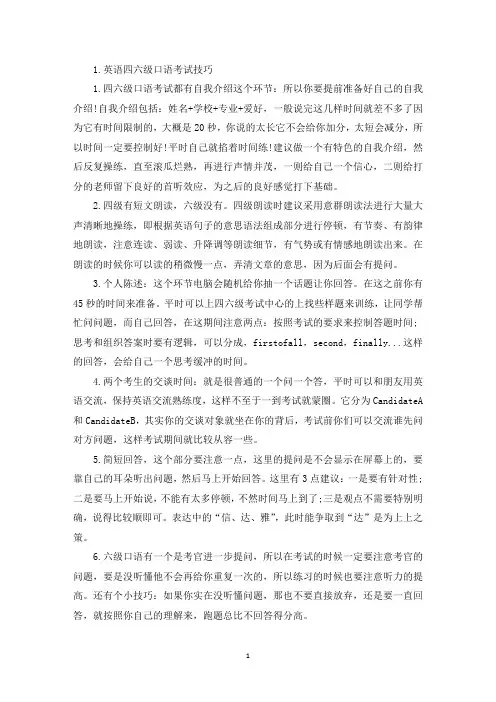
1.四六级口语考试都有自我介绍这个环节:所以你要提前准备好自己的自我介绍!自我介绍包括:姓名+学校+专业+爱好,一般说完这几样时间就差不多了因为它有时间限制的,大概是20秒,你说的太长它不会给你加分,太短会减分,所以时间一定要控制好!平时自己就掐着时间练!建议做一个有特色的自我介绍,然后反复操练,直至滚瓜烂熟,再进行声情并茂,一则给自己一个信心,二则给打分的老师留下良好的首听效应,为之后的良好感觉打下基础。
2.四级有短文朗读,六级没有。
四级朗读时建议采用意群朗读法进行大量大声清晰地操练,即根据英语句子的意思语法组成部分进行停顿,有节奏、有韵律地朗读,注意连读、弱读、升降调等朗读细节,有气势或有情感地朗读出来。
在朗读的时候你可以读的稍微慢一点,弄清文章的意思,因为后面会有提问。
3.个人陈述:这个环节电脑会随机给你抽一个话题让你回答。
在这之前你有45秒的时间来准备。
平时可以上四六级考试中心的上找些样题来训练,让同学帮忙问问题,而自己回答,在这期间注意两点:按照考试的要求来控制答题时间;思考和组织答案时要有逻辑,可以分成,firstofall,second,finally...这样的回答,会给自己一个思考缓冲的时间。
4.两个考生的交谈时间:就是很普通的一个问一个答,平时可以和朋友用英语交流,保持英语交流熟练度,这样不至于一到考试就蒙圈。
它分为CandidateA 和CandidateB,其实你的交谈对象就坐在你的背后,考试前你们可以交流谁先问对方问题,这样考试期间就比较从容一些。
5.简短回答,这个部分要注意一点,这里的提问是不会显示在屏幕上的,要靠自己的耳朵听出问题,然后马上开始回答。
这里有3点建议:一是要有针对性;二是要马上开始说,不能有太多停顿,不然时间马上到了;三是观点不需要特别明确,说得比较顺即可。
表达中的“信、达、雅”,此时能争取到“达”是为上上之策。
6.六级口语有一个是考官进一步提问,所以在考试的时候一定要注意考官的问题,要是没听懂他不会再给你重复一次的,所以练习的时候也要注意听力的提高。

英语四六级口语考试要求一、考试要求1.考试时间:口语考试时间一般为5-8分钟。
其中,四级口语考试有3个题目,六级口语考试有4个题目。
2.考试形式:口语考试是面对面的,通常为一对一或一对两个考官。
考官将针对每个题目提问和评分。
3.语言技能:考生需要展示流利、准确、连贯的口语表达能力和较高的听力理解能力。
4.评分标准:评分主要考虑以下方面:词汇和语法的准确性、流利程度、语音和发音的准确性,逻辑关系的连贯性,以及与考题的相关性和能力展示。
二、备考建议1.注重听力训练:口语考试的第一项基本要求是听力能力。
考生应多听英语电台、广播、英语角等英语资源,提高对真实语速的听力理解能力。
2.增加词汇量:词汇量是进行口语表达和理解的基础。
考生应扩大词汇量,并学习一些常用的口语表达,以便在考试中更自如地表达自己的观点。
3.提高语法水平:良好的语法基础对于准确表达观点是至关重要的。
考生应加强语法训练,熟练掌握各种句型的用法和搭配。
4.练习口语表达:考生可以通过模仿、背诵和对话练习来提高口语表达能力。
可以找一些英语口语练习的教材或者与他人进行模拟对话,增加对语言的熟悉程度。
5.提高答题速度:考生需要在规定时间内做出回答,因此需要提高答题速度。
练习时可以设置时间限制,模拟考试场景,培养自己在有限时间内清晰、连贯地表达观点的能力。
三、具体题型与答题技巧1.自我介绍题:考生需要在短时间内对自己进行简单介绍。
答题时可以从姓名、年龄、学校、专业、兴趣爱好等方面入手,同时积极展示自己的长处和特点。
2.图片题:考生需要根据一张或多张图片展开描述和讨论。
答题时可以先简单描述图片内容,然后进行分析、比较或进行推测,同时陈述自己的观点。
3.看图说话题:考生需要根据一张或多张图片进行连贯的讲述。
注意要正确理解图片内容,同时进行逻辑运用和适度的表达。
4.辩论题:考生需要对一些有争议的话题进行讨论。
答题时可以先展示自己的观点,然后给出理由和例子来支持自己的观点,并对于对方的观点提出合理的反驳。
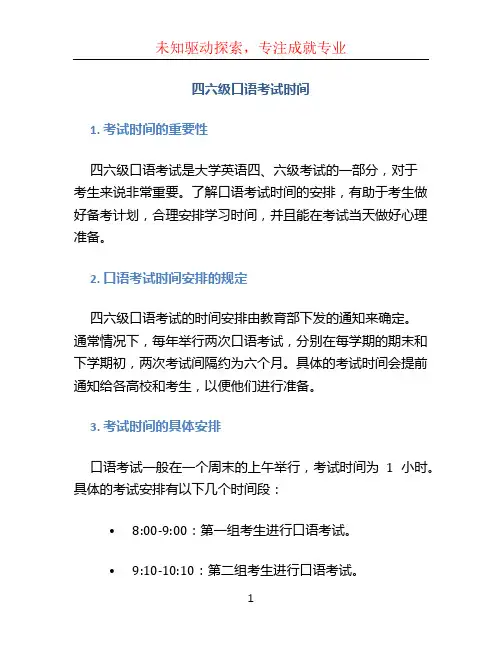
四六级口语考试时间1. 考试时间的重要性四六级口语考试是大学英语四、六级考试的一部分,对于考生来说非常重要。
了解口语考试时间的安排,有助于考生做好备考计划,合理安排学习时间,并且能在考试当天做好心理准备。
2. 口语考试时间安排的规定四六级口语考试的时间安排由教育部下发的通知来确定。
通常情况下,每年举行两次口语考试,分别在每学期的期末和下学期初,两次考试间隔约为六个月。
具体的考试时间会提前通知给各高校和考生,以便他们进行准备。
3. 考试时间的具体安排口语考试一般在一个周末的上午举行,考试时间为1小时。
具体的考试安排有以下几个时间段:•8:00-9:00:第一组考生进行口语考试。
•9:10-10:10:第二组考生进行口语考试。
•10:20-11:20:第三组考生进行口语考试。
每组考生的人数会根据实际情况来确定,一般会在20-30人左右。
4. 考试地点和考场安排口语考试通常在各高校的教学楼或者专门的考试中心进行。
考试中心会根据实际情况预留足够的考场,以满足所有考生的需求。
每个考场会配备专门的监考老师,负责考场秩序的维护和监督考试过程的公正。
考生需要按照考试通知上所述的时间和地点,提前到达考场,并准备好相应的考试材料。
5. 注意事项在参加口语考试之前,考生需要注意以下几个事项:•了解口语考试的具体题型和评分标准,做好相应的备考准备。
•提前检查并准备好所需的考试材料,如身份证、准考证等。
•按照考试通知上所示的时间提前到达考场,以免因迟到而影响考试。
•在考试过程中保持冷静和自信,遵守考试纪律,不得作弊。
6. 结语了解口语考试的时间安排对考生来说非常重要。
通过具体的时间了解,考生可以制定合理的备考计划,并在考试当天做好心理准备。
总之,四六级口语考试的时间安排严格遵循教育部的规定,具体的考试时间会提前通知给考生,考生需要严格按照通知要求参加考试。
希望本文对考生们有所帮助,祝大家都能取得好成绩!。
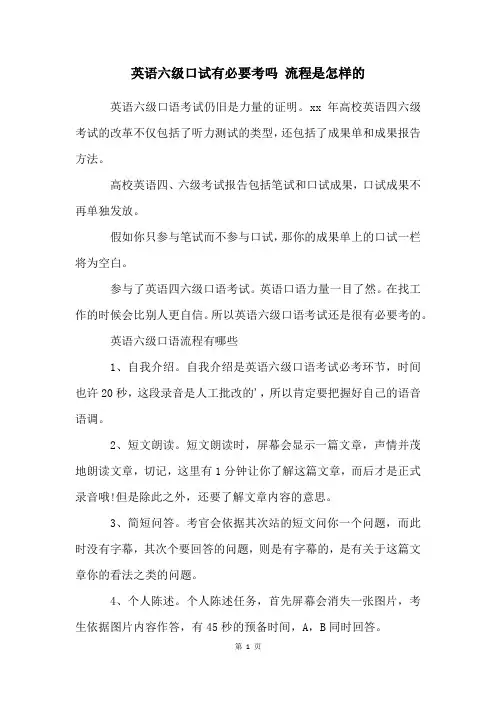
英语六级口试有必要考吗流程是怎样的英语六级口语考试仍旧是力量的证明。
xx年高校英语四六级考试的改革不仅包括了听力测试的类型,还包括了成果单和成果报告方法。
高校英语四、六级考试报告包括笔试和口试成果,口试成果不再单独发放。
假如你只参与笔试而不参与口试,那你的成果单上的口试一栏将为空白。
参与了英语四六级口语考试。
英语口语力量一目了然。
在找工作的时候会比别人更自信。
所以英语六级口语考试还是很有必要考的。
英语六级口语流程有哪些1、自我介绍。
自我介绍是英语六级口语考试必考环节,时间也许20秒,这段录音是人工批改的',所以肯定要把握好自己的语音语调。
2、短文朗读。
短文朗读时,屏幕会显示一篇文章,声情并茂地朗读文章,切记,这里有1分钟让你了解这篇文章,而后才是正式录音哦!但是除此之外,还要了解文章内容的意思。
3、简短问答。
考官会依据其次站的短文问你一个问题,而此时没有字幕,其次个要回答的问题,则是有字幕的,是有关于这篇文章你的看法之类的问题。
4、个人陈述。
个人陈述任务,首先屏幕会消失一张图片,考生依据图片内容作答,有45秒的预备时间,A,B同时回答。
个人陈述部分可根据“描述现象——分析缘由——提出建议”的结构绽开。
留意将陈述时间掌握在1分钟以内。
5.两人互动。
互动环节电脑屏幕会显示一个内容提纲,考生预备1分钟,A和B商量3分钟。
拓展阅读:六级口语考试评分标准A:能用英语就熟识的话题进行交谈,基本没有困难。
能就熟识的话题连贯地发表看法和看法。
能清楚、流畅地表达或描述一般性大事和现象。
B:能用英语就熟识的话题进行交谈,虽有些困难,但不影响交际。
能就熟识的话题作较连贯的发言。
能较清楚、流畅地表达或描述一般性大事和现象。
C:能用英语就熟识的话题进行简洁的交谈。
能就熟识的话题作简短的发言。
能简洁地表达或描述一般性大事和现象。
D:尚不具备英语口头交际力量。
英语四六级口试必须要考吗(不是)英语四六级口试必须要考吗英语四六级口语考试不是必须强制考的,是作为一个选考的项目。
口语考试对总体成绩是没有影响的,考下英语四六级口语,也不会单独发放成绩单,口试成绩在笔试成绩上统一体现。
英语四六级考试成绩是按照笔试来的,一般来说把425分做为英语四六级考试的及格标准,因为只有达到425以上才能考英语六级考试,一般来说不设及格标准。
英语四六级口语评分标准英语四六级口语评分主要是考查考生对一些语法或词汇的语音和语调、词汇和语法结构的复杂程度、范围的运用是否准确得当,还有在不同的场景中考生的应变能力和交际能力,以及语句的连贯性和不同场合选用语言的适当能力。
考生在备考英语四六级口语考试时,首先要准备一个让主考老师加深印象的自我介绍,针对一些当前热门的话题有所准备,同时要加强口语交流的练习,表述的内容一定要通顺,有条理,与主考老师交流一定要专心致志,最后争取在考场赢得好成绩。
英语四六级口试考试难吗四级口试的难度与大学期间可考的雅思、托福、BEC相对简单,并且口试的难度就对应着证书的含金量相对来说不高。
一方面是考试的内容简单,四级口试考试时间为10分钟,考试内容为阅读一段短文,在阅读过程中对于发音、熟练程度不做太大要求,基本上都能得C,稍作准备的可以得到B。
而英语六级口试相对来说有一定的难度。
考试分为自我介绍和问答、陈述和讨论、考官提问回答3部分。
准备考六级口语的同学一定要提前做好准备。
英语四六级口试和笔试多少分及格大学英语四六级及格线是425分。
大学英语四六级考试分为口试跟笔试,笔试出现缺考、违规及总成绩低于220分情况时,总成绩则报道为0分;D等级仅在当次考试成绩发布时可查询,成绩报告单上不报道。
因大学英语四、六级曾规定"英语四级成绩达到425分以上(含425分)者,可以报考英语六级”,所以,一般默认大学英语四六级的合格线为425分。
英语四六级口试和笔试的区别1、考试费用不同:由于英语四六级考试是由各院校教务处统一组织报名,所以各地区报名费用不同,具体费用请查看自己所在学校教务处具体通知。
四六级口语考试真题Topics for Oral ExamUnit 1 What do you think makes a good heart? Can you say something about someone you love?Unit 2 Misunderstandings are quite common in our daily lives. Can you come up with ways to avoid misunderstandings?Unit 3 What factors contribute to success? Do you think one can finally succeed in whatever he is doing by never giving up? Explain your answer with your own experiences or stories.Unit 4 Nowadays, college students are facing more and more stress. State the possible reasons for this phenomenon and make some advices on how college students maintain a healthy mind in a healthy body.Unit 5 What is your dream or ideal? How can you realize your dream?6. What are usually the daily activities for college students in China? Please talk about your daily schedule.7. Imagine you have three days off, and you’re planning to take a trip out of the city. What sort of places would youwant to visit? What would you do there?8. What was the best thing that’s ever happened to you or the worst thing you ever did as a child?9. What do you expect from a job? Would you rather have a secure job with a lower salary, or a job with less securitybut a higher salary? Why?10. If you were rich and didn’t have to work, would you still want a j ob? Why or why not?Part 1 (5 minutes)Examiner:Good morning (Good afternoon), everybody. Could you please tell me your name and the number of your admission ticket? Your name, please. And your number? … Your name? … And your number? ... Thank you.Now would you please briefly introduce yourselves to each other? Remember, you should not mention the name of your university. (1.5 minutes)OK, now that we know each other we can do some group work. First of all, I’d like to ask each of you to say something about life in the city.[ C1, C2, C3 ]1) How do you like living in Beijing ( Shanghai , Nanjing …)?2) What do you think is the most serious challenge of living in a city like Beijing ( Shanghai , Nanjing …)?3) How do you like shopping in a supermarket?4) Where would you like to live, downtown or in the suburbs, and why?5) What measures do you think we should take to reduce air pollution in Beijing ( Shanghai , Nanjing …)?6) Can you say something about the entertainment available in your city?7) Where would you like to find a job after graduation, in a big city like Beijing or Shanghai or in a small town and why?8) What’s your impression of the people in Beijing ( Shanghai , Nanjing …)?Part 2 (10 minutes)Examiner:Now let’s move on to something more specific. The topic for our discussion today is “City Traffic”. You’ll have a picture (some pictures) showing two different types of transport. I’d like each of you to give a brief description of each type and then compare t he two types. You’ll have one minute to prepare and each of you will have one and a half minutes to talk about the picture(s). Don’t worry if I interrupt you at the end of the time limit. Now here are your pictures.[1 minute later]Now, [ C1 ], would you please start first? [ C2 ] and [ C3 ], please put your pictures aside and listen to what [ C1 ] has to say.[1.5 minutes later] OK. [ C2 ], now it’s your turn.[1.5 minutes later] OK, [ C3 ], and now it’s your turn.Right. Now we all have some id ea of various kinds of city transport. I’d like you to discuss this topic further and see if you can agree on which is the best type of transport for a big city like Beijing ( Shanghai , Nanjing …). During the discussion you may argue with each other or ask each other questions to clarify a point. You will have about four and a half minutes for the discussion. Your performance will be judged according to your contributions to the discussion.[If one candidate talks too long]Sorry, I’ll have to stop you now. Let’s listen to what [ C? ] has to say.[If one candidate keeps silent for a long time] / [If the group is silent for some time, then ask one of the candidates to start the discussion.]Now, [ C? ], could you please say something about your view of …?[4.5 minutes later]All right, that’s the end of the discussion.Part 3 (5 minutes)Examiner:Now I’d like to ask you just one last question on the topic of “City Traffic”.[Select a question from the following list to ask each of the candidates.][ C1 or C2 or C3 ]? During the discussion, why did you say that ... ?? What kind of transport do you usually use in your city?? Do you have any suggestions as to how traffic conditions can be improved in big cities?? Do you think private cars should be encouraged?? Why do you think some Western countries encourage people to ride bicycles?Now, that’s the end of the test. Thank you, everybody.。
英语四六级口语考试形式和内容英语四六级口语考试形式和内容CET-SET 考试采用机考形式,每场考试由 2 名主考和 3 (或 4 )名考生组成:CET-SET 考试分三部分:英语四六级口语第一部分是考生和 CET 授权的主考进行交谈,采用问答的形式。
时间约 5 分钟。
英语四六级口语第二部分包括 1.5 分钟的考生个人发言和 4.5 分钟的小组讨论。
时间共约 10 分钟。
英语四六级口语第三部分由主考再次提问以进一步确定考生的口头交际能力。
时间约 5 分钟。
由于改革,有些省份实施机考形式。
两个考生为一组参加。
英语四六级口语第一部分为简单的自我介绍和问题回答,其中自我介绍20秒,问题回答为90秒。
英语四六级口语第二部分为topic,及与你的partner进行有关此给出话题的讨论,时间为4分30秒。
英语四六级口语第三部分为总结式回答,包括两个问题,其中一个与你的partner相同,另一个不同。
时间均为90秒。
英语四六级口语考试如何备考第一步:把你的根基搭建起来要提高口语的关键在于“互动”,就是必须回馈你所听到的东西,要去确认你是否听到,听对,听漏;无意识的学习是很浪费时间的,尤其是对于“没有多少时间的成年人”。
听力的方法:选择文本。
口语文本以你能看懂80%以上的,如果什么都看不懂,那么就赶紧去补单词,补句子,补阅读。
不建议去听那种每个词都不认识的*,因为……那种训练根本达不到效果,你都忙着查词去了第一遍听,大概抓住全文的要义。
听完以后,快速在脑子里过一遍*结构。
仔细听,愿意做听写的可以做听写,不愿意做的把听不明白的地方抓出来,反复跟读。
一定要做好笔记,把听不出来的东西反复听。
再听。
直到听懂为止。
要提高听力,最重要的是每天听,大量听,并且精听。
第二步:口语,从正确说话开始口音不是大事情,发错音才是大事情。
就那中文来说“吃饭”,这个词北方人可能会更卷舌,南方人的舌头则可能是偏直的(所以听起来很温柔),这个就是个人特色……但是,你不能把“吃饭”发成“滋饭”。
大学英语四六级口语考试有用吗英语四六级口语考试有用吗在未来,毕业找工作时,四级口语考试的成绩,也可以体现我们大学生英语口语水平。
不过,目前来说,四六级口语考试不是必报的,用人单位一般对四六级口语证不作要求。
对于英语口语较好的同学:英语好是一种能力的体现,更需要实质性的等级体现,另外值得说的是对于英语好想要做翻译的同学这样的考试就是更加有必要了。
英语不好的同学:可以把这一次当成一次体验,毕竟自我介绍、简单的口语问答,以后找工作也可能会用得到,早点感受一下纯英文的交流,未雨绸缪。
还可以在备考的过程中提升自己的口语能力。
国外交换生/出国留学英语是很多国家的官方语言,所以,掌握英语口语,相当于拥有了在很多国家学习深造的机会。
不管是本科生,还是硕士生、博士生,一些学校每年都会有对外交流项目。
只要你满足一定条件,就可以申请。
一般是去国外交流1年左右,这是一个很好的机会,不仅是公费出国,不需要担心没钱的问题,而且可以极大提高我们的视野,接触到更宽广的人脉。
对考研是复试拉分项很多同学过了考研初试,但考研复试被刷,其中重要的原因就是口语太差!口语能力考研复试必定考察的内容,包括英文的自我介绍和日常的提问交流,这个和四六级、雅思口语考试很像。
如果你的口语能力很出众,必然会在竞争激烈的考研复试中脱颖而出!英语四六级口语考试内容CET-SET 考试采用机考形式,每场考试由 2 名主考和 3 (或 4 )名考生组成:CET-SET 考试分三部分:第一部分是考生和 CET 授权的主考进行交谈,采用问答的形式。
时间约 5 分钟。
第二部分包括 1.5 分钟的考生个人发言和 4.5 分钟的小组讨论。
时间共约10 分钟。
第三部分由主考再次提问以进一步确定考生的口头交际能力。
时间约 5 分钟。
由于改革,有些省份实施机考形式。
两个考生为一组参加。
第一部分为简单的自我介绍和问题回答,其中自我介绍20秒,问题回答为90秒。
第二部分为topic,及与你的partner进行有关此给出话题的讨论,时间为4分30秒。
英语四、六级口试有什么用英语四、六级口试有什么用四六级口语考试考查的是学生的口语能力,而英语口语好不好通过一个证书也反馈不出来,最重要的就是自己的能力了,流利的口语可以让你轻松进入外资企业。
以下是店铺整理的关于英语六级口试的作用,希望大家认真阅读!一、评分标准CET-SET主考在评分时使用以下标准:a.准确性指考生的语音、语调以及所使用的语法和词汇的准确程度b.语言范围指考生使用的词汇和语法结构的复杂程度和范围c.话语的长短指考生对整个考试中的交际所作的贡献、讲话的.多少d.连贯性指考生有能力进行较长时间的、语言连贯的发言e.灵活性指考生应付不同情景和话题的能力f.适切性指考生根据不同场合选用适当确切的语言的能力二、语言功能CET-SET考试要求考生参与不同形式的口头交际,其语言能力将根据其在考试中的表现予以测量。
考生需要掌握的语言功能和意念在《大学英语教学大纲》中已明确列出。
以下仅列举其中部分的语言功能和意念。
友好往来问候,介绍,告别和告辞,祝愿和祝贺,感谢和应答,道歉和应答,提议、邀请和应答。
相互交流开始交谈,继续交谈,改变话题,停止交谈。
态度愿意,希望,意向,决心,责任,能力,允许,禁止,同意和不同意,否定,喜欢和不喜欢,偏爱,责怪和抱怨,判断、决定和意见。
劝说命令,劝告和建议,承诺,提醒。
感情焦虑,惊奇,兴趣,加重感情色彩。
存在存在和不存在,有和没有。
空间描述位置,方向,运动,距离。
时间时刻,时段,时间关系,频度,时序。
发表意见和看法询问意见和看法,发表意见和看法,对意见和看法的反应,同意,不同意,要求澄清,澄清意见和看法。
争辩讨论,讨论观点,反驳论点,提出进一步论证,劝说和对劝说的反应。
三、考试形式CET-SET考试分三部分:第一部分是考生和CET授权的主考进行交谈,采用问答的形式。
时间约5分钟。
第二部分包括1.5分钟的考生个人发言和4.5分钟的小组讨论。
时间共约10分钟。
第三部分由主考再次提问以进一步确定考生的口头交际能力。
如何准备英语四六级口语考试英语四六级考试中的口语部分是许多考生最为担心的考试项目,因为很多人并没有系统地学习口语。
然而,如果你掌握了一些技巧和方法,准备口语考试并不是一件难事。
以下是一些有用的技巧和方法:1. 练习发音正确的发音是口语考试中最重要的一步。
正确的发音可以让你的交流更容易,也可以让你听懂别人说话。
练习发音的最好方法是听磁带或CD,跟读里面的内容,模仿着语调和节奏。
另外,可以通过参加语言角、英语电影和音乐等活动来提升发音。
2. 提高词汇量如果你要在口语考试中流畅地表达自己的观点,就需要充分地掌握词汇。
建议考生通过阅读英语报纸、杂志和文学作品来扩大词汇量,同时积极记忆生词与短语。
3. 注意语法和句型在口语考试中,语法和句型都是至关重要的。
因此,考生要熟悉基本语法规则和常见句型,能够熟练地应用到口语当中。
另外,考生可以从教材或者英语学习网站上寻找一些典型的例句,背诵并且模仿使用。
4. 多练习口语练习口语是准备四六级口语考试最重要的方法,可以通过观看英语电影、练习对话、参加语言角等方式来锻炼。
在练习口语时,需要注意语音、语调、语速和流畅度等方面。
建议考生做足充分的准备,多想想可能会被考官问到的问题,事先做好充分准备。
5. 关注新闻和时事当前社会变化日新月异,新闻及时发生。
更好地准备口语考试需要保持跟政治、文化等领域发生的变化,这样可以更好地讲述自己的见解和看法。
可以通过观看新闻、阅读报纸等方式来掌握时事新闻与政治热点。
总之,准备四六级口语考试需要综合考虑多方面因素,如发音、词汇量、语法、句型、思维逻辑等。
以上的技巧和方法,可以为考生提供一些有用的指导,帮助他们更好地准备口语考试,取得更好的成绩。
英语四六级口语考试大学英语四、六级考试口语考试( CET Spoken English Test ,简称CET-SET )用于测量我国大学生运用英语进行口头交际的能力。
考试对象CET-SET 报考对象为获得全国大学英语四、六级证书且成绩达到一定分数线的在校大学生。
试行阶段的报考对象根据教育部有关文件决定,具体报名规定见考试委员会通知。
考试时间一年两次,分别在 5 月和 11 月。
考试形式CET-SET 考试采用面对面的形式,每场考试由 2 名主考和 3 (或 4 )名考生组成:CET-SET 考试分三部分:第一部分是考生和 CET 授权的主考进行交谈,采用问答的形式。
时间约 5 分钟。
第二部分包括分钟的考生个人发言和分钟的小组讨论。
时间共约10 分钟。
第三部分由主考再次提问以进一步确定考生的口头交际能力。
时间约5 分钟。
试题构成Part 15 分钟问答“热身”题,包括考生自我介绍、回答问题。
Part 210 分钟发言和讨论考生准备 1 分钟后,根据所给提示作一个分钟的发言;小组就指定的话题讨论(约分钟)。
Part 35 分钟问答由主考进一步提问。
考试成绩考试总分为 15 分,分为 A 、 B 、 C 和 D 四个等级。
C 等以上者将获得由教育部高教司颁发的注有 CET Spoken English Test 成绩等级的CET 证书能力等级标准A+ 分A 分能用英语就熟悉的题材进行口头交际,基本上没有困难。
B+ 分B 分能用英语就熟悉的题材进行口头交际,虽有些困难,但不影响交际。
C+ 分C 分能用英语就熟悉的题材进行简单的口头交际。
分以下尚不具有英语口头交际能力。
5 分? 语法和词汇基本正确? 表达过程中词汇丰富、语法结构较为复杂? 发音较好,但允许有一些不影响理解的母语口音? 在讨论有关话题时能进行较长时间的、语言连贯的发言,但允许由于无法找到合适的词语而造成的偶尔停顿? 能够自然、积极地参与讨论? 语言的使用总体上能与语境、功能和目的相适应4 分? 语法和词汇有一些错误,但未严重影响交际? 表达过程中词汇较丰富? 发音尚可? 能进行较连贯的发言,但多数发言较简短? 组织思想和搜寻词语时频繁出现停顿,有时会影响交际? 能够较积极地参与讨论,但有时内容不切题或未能与小组成员直接交流? 语言的使用基本上能与语境、功能和目的相适应3 分? 语法和词汇有错误,且有时会影响交际? 表达过程中词汇不丰富,语法结构较简单? 发音有缺陷,有时会影响交际? 发言简短? 组织思想和搜寻词语时频繁出现较长时间的停顿,影响交际,但能够基本完成交际任务? 不能积极参与讨论,有时无法适应新话题或讨论内容的改变2 分? 语法和词汇有较多错误,以致妨碍理解? 表达过程中因缺乏词汇和语法结构而影响交际? 发音较差,以致交际时常中断? 发言简短且毫无连贯性,几乎无法进行交际? 不能参与小组讨论大学英语四、六级考试口语考试样题CET Spoken English TestSample PaperTopic A - 1Topic Area : City LifeTopic : City TrafficPart 1 (5 minutes)Examiner:Good morning (Good afternoon), everybody. Could you please tell me your name and the number of your admission ticket Your name, please. And your numb er … Your name … And your number ... Thank you.Now would you please briefly introduce yourselves to each other Remember, you should not mention the name of your university. minutes)OK, now that we know each other we can do some group work. First of all, I'd like to ask each of you to say something about life in the city.[ C1, C2, C3 ]1) How do you like living in Beijing ( Shanghai , Nanjing …)2) What do you think is the most serious challenge of living ina city like Beijing ( Shanghai , Nanjing …)3) How do you like shopping in a supermarket4) Where would you like to live, downtown or in the suburbs, and why5) What measures do you think we should take to reduce air pollution in Beijing ( Shanghai , Nanjing …)6) Can you say something about the entertainment available in your city7) Where would you like to find a job after graduation, in a big city like Beijing or Shanghai or in a small town and why8) What's your impression of the people in Beijing ( Shanghai , Nanji ng …)Part 2 (10 minutes)Examiner:Now let's move on to something more specific. The topic for our discussion today is “City Traffic”. You'll have a picture (some pictures) showing two different types of transport. I'd like each of you to give a brief description of each type and then compare the two types. You'll have one minute to prepare and each of you will have one and a half minutes to talk about the picture(s). Don't worry if I interrupt you at the end of the time limit. Now here are your pictures.[1 minute later]Now, [ C1 ], would you please start first [ C2 ] and [ C3 ], please put your pictures aside and listen to what [ C1 ] has to say.[ minutes later] OK. [ C2 ], now it's your turn.[ minutes later] OK, [ C3 ], and now it's your turn.Right. Now we all have some idea of various kinds of city transport. I'd like you to discuss this topic further and see if you can agree on which is the best type of transport for a big city like Beijing ( Shanghai , Nanjing …). During the discussion you may argue with each other or ask each other questions to clarify a point. You will have about four and a half minutes for the discussion. Your performance will be judged according to your contributions to the discussion.[If one candidate talks too long]Sorry, I'll have to stop you now. Let's listen to what [ C ] has to say.[If one candidate keeps silent for a long time] / [If the group is silent for some time, then ask one of the candidates to start the discussion.]Now, [ C ], could you please say something about your view of …[ minutes later]All right, that's the end of the discussion.Part 3 (5 minutes)Examiner:Now I'd like to ask you just one last question on the topic of “City Traffic”.[Select a question from the following list to ask each of the candidates.][ C1 or C2 or C3 ]? During the discussion, why did you say that ...? What kind of transport do you usually use in your city? Do you have any suggestions as to how traffic conditions can be improved in big cities? Do you think private cars should be encouraged? Why do you think some Western countries encourage people to ride bicyclesNow, that's the end of the test. Thank you, everybody.体例说明:内容体例举例? 主考用语 :黑体Good morning.? 对主考的提示 :[ 白体 ][Interrupt him/her if …]? 变量(考生姓名) :[ 斜体 ][ C1 ]? 时间提示 :( 白体 )(5 minutes)? 过程说明 :斜体Part 1? 可变换的内容 :( )Good morning (Good afternoon)。